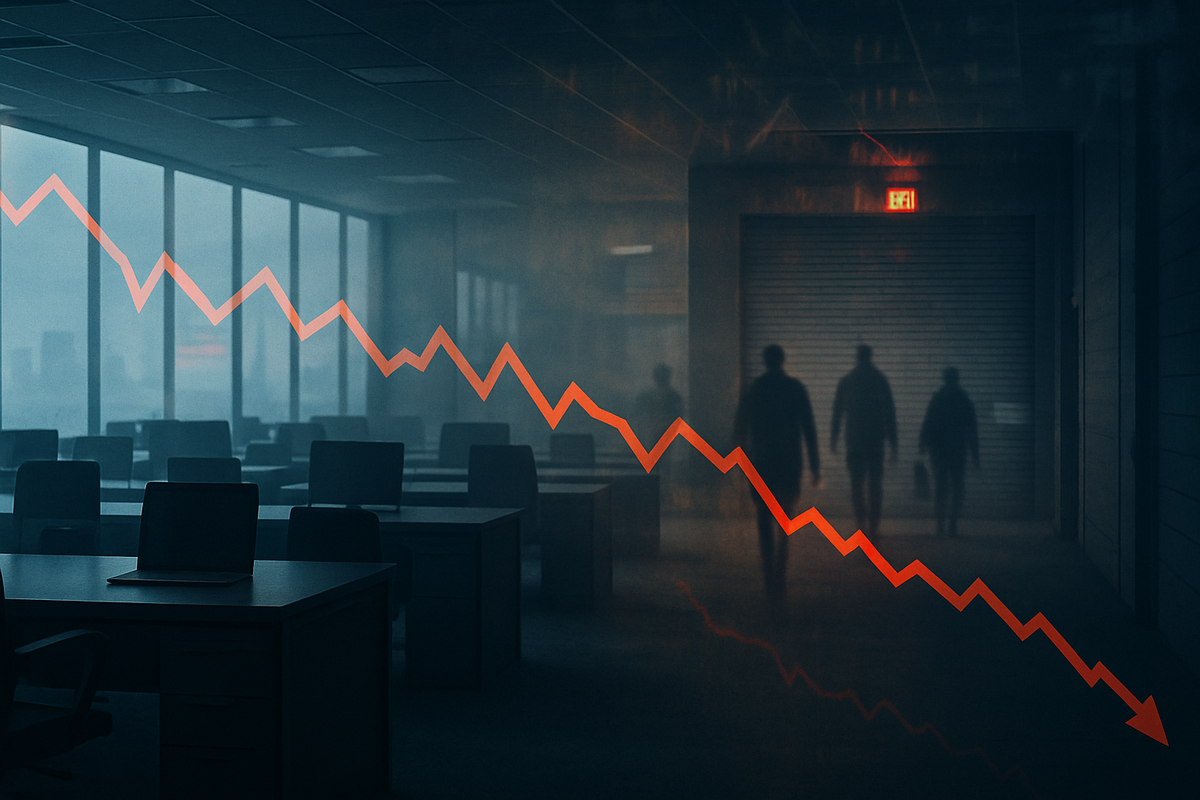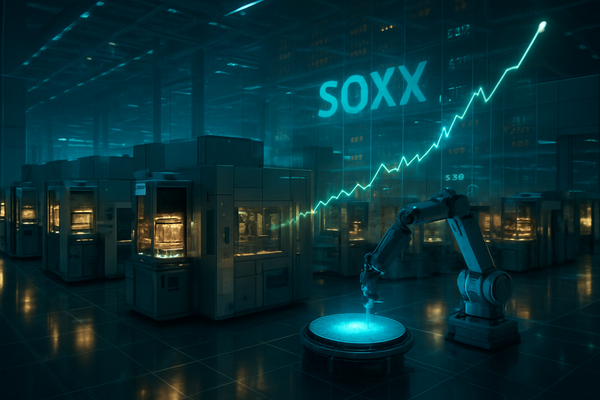U.S. Economy on Edge: 'Jobs Recession' and Shrinking Workforce Stoke Recession Fears

The United States economy is facing an increasingly perilous path, with a looming shadow of recession cast by the intertwined phenomena of a "jobs recession" and a fundamentally shrinking workforce. Economic analysts are sounding alarms, suggesting that these critical labor market shifts are immediately escalating the probability of a U.S. economic downturn. This isn't just about slower job growth; it's about a structural transformation of the labor market that could have profound and lasting implications for consumer spending, business investment, and overall economic stability.
Recent data paints a stark picture of an economy losing momentum where it matters most: employment. The implications extend far beyond mere statistics, potentially reshaping monetary policy, market sentiment, and the very fabric of American enterprise. As hiring flatlines and the pool of available workers contracts, the nation stands at a critical juncture, prompting urgent questions about the path ahead.
The Economic Storm Brews: What Happened and Why It Matters
The U.S. economy has demonstrably entered a "jobs recession," a term gaining traction among economists to describe a significant downturn in the labor market even before a broader economic recession is officially declared. This condition is characterized by decreasing job growth, declining payroll employment, and a rising unemployment rate. A key indicator of this weakening was the Bureau of Labor Statistics' (BLS) substantial downward revision of job growth figures from April 2024 to March 2025, slashing over 900,000 previously reported jobs – the largest such adjustment in over a decade. This revision suggests that the labor market was far less robust than initially perceived, painting a dramatically different picture of economic health.
Adding to this immediate concern is the structural issue of a shrinking workforce, which refers to a sustained reduction in the labor force participation rate – the percentage of the working-age population either employed or actively seeking work. This long-term trend is primarily driven by an aging population, specifically the ongoing retirement of the Baby Boomer generation (with the last cohort reaching traditional retirement age by 2029). Furthermore, declining U.S. birth rates since the 2008 Great Financial Crisis and lower net migration contribute significantly to this diminishing labor supply. The BLS projects the labor force participation rate to decline from 62.7% to 61.2% by 2033, with population growth expected to outpace labor force growth by an alarming 8 to 1 ratio over the next eight years.
Economists like Mark Zandi, Chief Economist at Moody's Analytics, have explicitly stated that the U.S. economy has entered a "jobs recession," noting that "hiring has flatlined and momentum has all but vanished." He recently placed the probability of a U.S. recession in the next 12 months at an "uncomfortably high" 48%. This elevated risk stems from several interconnected mechanisms. A weakening job market leads directly to reduced consumer income and confidence, which in turn curtails consumer spending – the primary engine of economic activity. Simultaneously, a shrinking workforce means fewer individuals contributing to the nation's output, thus slowing GDP growth and making the economy less resilient to external shocks. This creates a dangerous feedback loop where job losses reduce spending, further hurting demand and potentially leading to more widespread layoffs, pushing the economy into a full-blown recession.
The current economic sentiment is one of increasing caution. While official GDP growth might still show some positive signs, concerns about the labor market are mounting, especially for young workers who are struggling with higher unemployment rates and sluggish hiring in traditional entry-level sectors. The significant downward revisions in job data have also led financial markets to price in more aggressive interest rate cuts from the Federal Reserve, anticipating weaker economic momentum. This reassessment has critical implications for monetary policy, market sentiment, and economic forecasting, forcing a re-evaluation of the nation's true economic footing.
Navigating the Downturn: Winners and Losers Emerge
The current economic climate, characterized by a jobs recession and a shrinking workforce increasing the likelihood of a U.S. recession, will inevitably create a bifurcated market of winners and losers across various sectors and public companies. Industries heavily reliant on discretionary consumer spending or a large, readily available labor pool are most vulnerable, while those offering essential goods, services, or solutions to labor scarcity are likely to prove more resilient, or even thrive.
On the Losing End:
Sectors tied to Consumer Discretionary spending are immediately susceptible. Companies in retail, hospitality, travel, and arts & entertainment will face significant headwinds as job insecurity and tighter budgets lead consumers to cut back on non-essential purchases. For instance, major airlines like Delta Air Lines (NYSE: DAL) and United Airlines Holdings (NASDAQ: UAL) could see reduced leisure and business travel. Full-service restaurant chains and hotels would also feel the pinch of reduced patronage. Retailers specializing in luxury goods or non-essential electronics would experience declining sales. The Construction & Real Estate sector is another high-risk area, as high interest rates and job security concerns deter homebuyers and slow new construction projects. Home builders such as D.R. Horton (NYSE: DHI) and Lennar Corporation (NYSE: LEN) could face reduced demand and revenue.
The Manufacturing sector, especially for durable goods like automobiles and household appliances, will also struggle with reduced consumer demand. Companies like General Motors (NYSE: GM) and Ford Motor Company (NYSE: F) could see vehicle sales decline as consumers delay large purchases, opting for repairs instead. Even segments of the Information Services & Technology sector, particularly those that saw overhiring during the pandemic boom, continue to face job losses. Tech giants like Amazon (NASDAQ: AMZN), Alphabet (NASDAQ: GOOGL) (Google's parent company), Meta Platforms (NASDAQ: META), and Microsoft (MSFT) have already undertaken significant layoffs in 2024 and 2025, and further economic contraction could lead to more belt-tightening and a slowdown in business investment in non-essential tech solutions.
Finding Resilience and Opportunity:
Conversely, several sectors are poised for resilience or even growth. Healthcare is traditionally recession-resistant because demand for essential medical services remains largely inelastic. Pharmaceutical companies like Regeneron Pharmaceuticals (NASDAQ: REGN) and health insurance providers such as The Cigna Group (NYSE: CI) are likely to maintain stable demand. The aging population further guarantees consistent growth in this sector. Utilities companies, including NextEra Energy (NYSE: NEE) and Duke Energy (NYSE: DUK), provide essential services that consumers cannot easily forgo, ensuring stable demand and often reliable dividends, making them attractive defensive plays.
Consumer Staples businesses, which produce basic necessities, tend to thrive during downturns as consumers prioritize essentials. Grocery chains like Walmart (NYSE: WMT) and Kroger (NYSE: KR), along with discount retailers such as Dollar General (NYSE: DG), benefit from shifts towards value-conscious purchasing. Manufacturers of essential packaged goods, like The Hershey Company (NYSE: HSY), often see stable or even increased demand for affordable comfort items. Furthermore, the Auto Repair & Maintenance sector could see a boost as individuals forgo new car purchases and instead invest in extending the life of their current vehicles, benefiting companies like AutoZone (NYSE: AZO) and O'Reilly Automotive (NASDAQ: ORLY). Similarly, Home Improvement Retailers like The Home Depot (NYSE: HD) and Lowe's Companies (NYSE: LOW) could see stable demand as consumers opt for DIY repairs over costly professional services or new home purchases.
Crucially, the shrinking workforce itself presents opportunities for Technology companies specializing in automation, AI, and robotics. Businesses will increasingly invest in these solutions to offset labor shortages and boost productivity. Companies like Rockwell Automation (NYSE: ROK), providing industrial automation, or emerging AI software providers could see increased demand as industries seek to do more with fewer human hands.
Broader Implications: A Shifting Economic Landscape
The convergence of a 'jobs recession' and a shrinking workforce, driving up the probability of a U.S. recession, represents more than just a cyclical downturn; it signals profound, long-term shifts in the U.S. economic landscape with wide-ranging industry impacts and policy implications.
This event fits squarely into broader demographic and structural economic trends that have been unfolding for decades. The most significant is the aging of the U.S. population and the accelerated retirement of the Baby Boomer generation, which means fewer workers are entering the labor force to replace those exiting. This trend, coupled with declining birth rates since the 2008 financial crisis and more restrictive immigration policies, has led to a sustained downward trajectory in the overall labor force participation rate. These factors collectively contribute to slower potential economic growth, as labor force expansion is a key component of GDP growth. This demographic squeeze means the economy must achieve higher productivity gains per worker to maintain previous growth rates, or accept a future of slower expansion.
The ripple effects across competitors and partners are substantial. Industries heavily reliant on a stable and growing labor supply, such as labor-intensive manufacturing, logistics, and parts of the service sector, will face increased operating costs due to labor scarcity and potential disruptions. Businesses that cannot adapt by automating processes or significantly boosting worker productivity will lose competitiveness. Conversely, companies providing automation, AI solutions, or efficiency-enhancing technologies will likely see increased demand as businesses seek to mitigate labor shortages. Smaller businesses, often less equipped to absorb rising labor costs or invest in costly automation, may struggle more than larger, well-capitalized corporations, potentially leading to increased industry consolidation as stronger players acquire distressed competitors. Globally, a U.S. recession stemming from these factors could trigger capital outflows from emerging markets, disrupt international trade, and impact global investment flows, given the interconnectedness of the world economy.
The regulatory and policy implications are complex and challenging for policymakers. The Federal Reserve faces a formidable dilemma: a weakening labor market pressures them to cut interest rates to stimulate the economy, but if inflation remains stubbornly above target, aggressive cuts risk a renewed inflationary surge – a "stagflationary" trap. This delicate balancing act could necessitate unconventional monetary tools. On the fiscal front, governments will grapple with declining tax revenues from a shrinking workforce and potentially higher unemployment, while simultaneously facing increased demands for social safety nets like Social Security and Medicare from an aging population. This fiscal squeeze could lead to difficult debates over taxation, spending cuts, or increased national debt. Policymakers will also need to consider reforms to boost labor force participation, such as investing in education and training programs for new skills, and potentially reassessing immigration policies to attract and retain skilled workers, a strategy many other developed nations have explored.
Historically, periods of significant labor market distress have profound and lasting impacts. The Great Recession (2007-2009) saw skyrocketing unemployment and a substantial decline in the employment-to-population ratio, particularly for men, with workers experiencing persistent earnings losses even after recovery. While the current situation differs from the housing bubble and financial crisis of that era, the underlying demographic forces present a unique, long-term challenge. Countries like Japan and several European nations have already confronted the economic ramifications of aging populations and shrinking workforces, including reduced economic activity and significant fiscal strain, offering a cautionary tale for the U.S. The current scenario is not just a downturn but a fundamental reordering of economic dynamics, demanding adaptive strategies from both the public and private sectors.
The Road Ahead: Navigating an Uncertain Future
The path forward for the U.S. economy, under the duress of a jobs recession and a shrinking workforce, is fraught with both short-term challenges and long-term uncertainties. The immediate future will likely be characterized by slower economic growth, potentially leading to a mild recession, while the long-term outlook necessitates fundamental shifts in how businesses operate and how government policies are formulated.
In the short term, the primary focus will be on the Federal Reserve's response. Financial markets are already anticipating more aggressive interest rate cuts in light of weakening job data. While rate cuts might offer some relief to interest-sensitive sectors, they also carry the risk of reigniting inflation if not carefully managed. Businesses will likely continue to exhibit a "low hire, low fire" mentality, reluctant to both rapidly expand headcount or engage in widespread layoffs unless economic conditions deteriorate significantly. This cautious approach could lead to persistent underemployment and stagnant wage growth for many. Consumer spending, the bedrock of the U.S. economy, will likely remain subdued as job insecurity and economic uncertainty persist.
Looking further ahead, the structural challenge of a shrinking workforce will demand significant adaptations. Businesses will increasingly turn to automation, artificial intelligence (AI), and robotics to offset labor shortages and boost productivity. This could create a bifurcated job market, where demand for highly skilled tech professionals grows, while roles susceptible to automation decline, impacting less-skilled workers. Strategic workforce planning will become paramount, with companies focusing on retaining existing talent through upskilling, internal mobility, and fostering engaging work cultures. Government policies may need to encourage these technological adoptions, alongside investments in education and vocational training to ensure the workforce possesses the skills required for the jobs of the future. Reforming immigration policies to attract skilled workers could also become a vital strategy to bolster the labor supply.
Market opportunities will emerge for companies providing solutions to these challenges, particularly in the automation, AI, and robotics sectors. Healthcare and services catering to an aging population will continue to see strong demand. However, significant challenges loom, including intensified competition for a limited talent pool, rising labor costs in certain sectors, and decreased overall consumer demand impacting discretionary spending. The risk of "stranded capital" in labor-intensive industries that cannot adapt to automation or labor scarcity is also a concern.
Potential scenarios range from a "soft landing," where the Fed successfully navigates inflation and a weakening labor market to avoid a deep recession, to a more challenging period of "stagflation," where persistent inflation coexists with economic stagnation. A deep or prolonged recession, exacerbated by underlying demographic issues, remains a worst-case scenario. The ability of businesses and policymakers to strategically pivot – embracing technological solutions, investing in human capital, and implementing adaptive fiscal and monetary policies – will determine which scenario ultimately unfolds.
Conclusion: A New Economic Reality Dawns
The confluence of a 'jobs recession' and a structurally shrinking workforce marks a pivotal moment for the U.S. economy, significantly increasing the probability of a recession. This is not merely a transient economic fluctuation but rather a reflection of deeper demographic and structural shifts that promise to redefine the "normal" functioning of the labor market and broader economic growth for years to come.
The key takeaways are clear: the U.S. labor market is weakening far more than previously understood, with revised job numbers and rising long-term unemployment signaling a significant loss of momentum. This immediate downturn is amplified by the persistent, long-term challenge of a shrinking workforce driven by an aging population, declining birth rates, and reduced immigration. These two forces combined erode consumer confidence, dampen spending, and strain public finances, making a broader economic contraction increasingly likely.
Moving forward, the market will contend with increased volatility and uncertainty. The Federal Reserve's response to the weakening labor market will be crucial, with expectations of interest rate cuts already influencing market sentiment. However, investors should be wary, as initial rate cuts can sometimes signal underlying economic distress rather than a healthy recovery. Sectors tied to essential goods and services (consumer staples, healthcare, utilities) are likely to show greater resilience, while those reliant on discretionary spending (retail, hospitality, manufacturing of durable goods) will face considerable headwinds. The "new normal" will likely involve slower job growth, persistent labor shortages in key areas, and a renewed emphasis on productivity gains through technology.
The significance and lasting impact of these trends cannot be overstated. We are witnessing a redefinition of the labor market, where demographic constraints will increasingly influence economic potential. This could lead to slower per-capita GDP growth, increased fiscal pressures on social programs, and potentially a more challenging environment for younger generations entering the workforce. The risk of increased economic inequality and the urgent need for strategic investment in human capital and technological innovation will be central to navigating this new reality.
For investors in the coming months, vigilance and a strategic approach are paramount. Watch key economic indicators beyond headline GDP, focusing on granular labor market data such as monthly non-farm payrolls, weekly initial jobless claims, and the unemployment rate, particularly the "Sahm Rule." Anticipate Fed moves, as interest rate cuts will impact rate-sensitive sectors. Manage risk and diversify portfolios by considering a shift towards more defensive sectors. Most importantly, focus on long-term trends: identify and invest in companies and sectors that are well-positioned to adapt to or benefit from a shrinking workforce, such as those leveraging AI and automation for productivity or serving the needs of an aging population. Stay informed on corporate earnings, particularly for companies in discretionary sectors, as downward revisions can signal broader economic weakness. The coming months will require careful navigation and a keen understanding of the profound structural changes underway.



